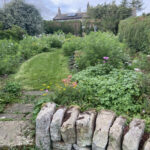1) Water deeply
When it’s hot and sunny it’s tempting to zip around the garden watering everything but beware, most people water too little. Watering a little bit only wets the top surface of the soil, I’ve seen some people water so lightly it might only wet a few millimetres of the surface. This surface moisture is easily evaporated by the heat of the day before the plant might have a chance to soak it up. Watering is best done deeply, by giving plants a good enough soak to get right down into the soil and the plant’s lower roots, which could be 20-30cm deep into the soil. You don’t have to pour gallons and gallons of water on, but you do need to add enough that you know it will soak through the soil and down. By watering deeply, the majority of water will go below that surface where it will be locked in away from the scorch of hot summer air and the sun. If in doubt, have a little dig with a trowel to see how far the water has gone, being careful not to damage too many roots.
2) Be targeted
It’s important to target water at plant roots, this means watering a circle around the base of the plant. In the summer it doesn’t matter so much if you get water on the stem or growing points of plants as it’s so dry but I generally try to avoid this because it can lead to some problems like rot or mildew and because it’s less wasteful to make sure all water goes to the soil and roots. It changes with each plant but generally it helps to imagine roots spread to the width of the plant above ground. That’s not always the case because many plant roots spread much further while others go straight down, but for the purpose of watering, this can be helpful. I then water that area of soil beneath the plant.
3) Wet dry soils
We’ll all have experienced very dry soil and the way water runs off the top of it or down cracks formed in clay soils. It’s one of the big concerns in our flood prone valley, that heavy rain will run off the solid dry top soil causing flash floods. The easiest way of remedying this in the garden is to damp the soil a little first. I do this on my allotment by watering a run of plants twice, going down the row first with a little water to let it soak into the soil and then going back through the line with the main watering which is drawn down after the previous water. Sometimes if particularly dry, I’ll do the initial water for most things on the allotment and then go back to the start, letting the water soak in for longer.
4) Wait for water to soak in
Related to the above, if you’re giving plants a good drench, keep an eye that the soil hasn’t reached a temporary saturation and it starts running away from the plant across the surface. If the water starts pooling, pause watering for a few seconds to watch the pool soak in before continuing. Control the flow rate of the watering can.
5) Water pots from below
Exactly as above, pots can dry out completely and compost can be hard to water without it running straight through the dry compost. I almost always water pot plants from below using a tray or dish of some kind. The compost then draws the water up slowly. You can dunk smaller pots in a bucket for a faster fix as the compost soaks water like a sponge. Finally, you could do the same technique as for plants in the ground, adding a little water and waiting for it to be absorbed before a main watering. But if the compost of a pot is this dry, it’s usually good to use a faster fix.
6) Create soil dishes around plants
I wrote about this in my book A Greener Life as a simple technique for reducing water run off around the plants, which I learnt in Morocco. Simply mound a little soil to create a flat dish around plants so you can water a good amount without it running across dry soils. This helps with points 1 – 4. In the UK people can be overly worried about rotting crowns but this usually happens in winter on plants that can’t handle very wet and cold conditions and you can avoid it by brushing away the ring of soil if you’re really worried, I find that unnecessary.
7) Mulch to improve soils long term
I mulch our soil a little each year on our vegetable patch using peat free compost between autumn and spring which helps to make our loamy-clay soil like a sponge. On my London allotment the soil was extremely dry and sandy and the compost helped do the same in a slightly different way. Clay soil is very water retentive but can dry solid in drought causing water to run off or through cracks, while sandy soil drains freely. Adding the compost which is sponge like and water retentive helps create a better environment in all soils, drawn in by soil organisms, such as worms and bacteria.
8) Emergency mulch to lock in moisture
Mulch can be used in a more specific targeted way to help during times of drought by acting like a cap on top of soil you have just watered well. By spreading a few centimetres of mulch around a watered plant, it will lock it in by effectively raising the soil level and burying the dampened soil from the heat of the sun. I use regular peat free compost for this, though composted bark works well too. You could use gravel, which works really well at locking moisture in beneath they layer of stone but I’m steering away from too much gravel due to sustainability reasons (the stone comes from somewhere and is transported) and not wanting to fundamentally change soil composition. Plant based mulches replicate nature, to a degree.



